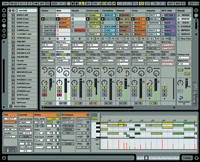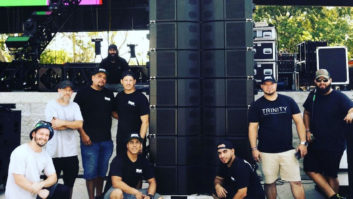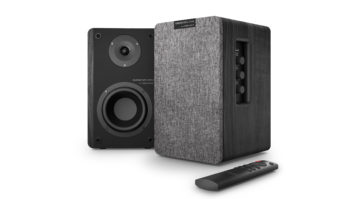

Ableton Live is billed as a “sequencing instrument” — a great description of this popular Mac/Windows program. Live is a specialized digital audio — and now MIDI — sequencer that is set up for triggering and processing patterns and loops in real time. You can work with pre-made loops or make your own. In addition to acting as a traditional DAW, Live can automatically trim your recordings into loops.
As its name implies, Live is designed for performance applications that have an unknown duration, including when you need to anticipate how long a solo is going to go, how long a vamp is going to continue or, in theatrical applications, how long an actor might take to exit the stage. It’s also set up to allow creative manipulation of all the performance elements in real time, which is why it has become so popular among DJs and remixers. The program is also an outstanding studio production tool.
In the tradition of Sonic Foundry’s Acid, Live automatically time compresses/expands clips (pieces of audio) to fit the current tempo, but you do have to manually transpose them to the current key. What’s really great is that files on your hard drive are automatically time-stretched to the right tempo while you’re auditioning them as the sequencer plays. Of course, Live is also capable of recording audio directly, now at up to 24-bit/96kHz resolution, and it will automatically make clips into loops. You can then arrange, process, manipulate and mix the clips to quickly build arrangements. Live has 17 wacky audio effects built-in, all set up for real-time control, and you can use any VST or AudioUnits (Mac OS X only) plug-ins in your arsenal. Simply drag an effect in to use it on a track or shared return track; it’s not necessary to stop the sequencer.
Version 4 comes with two simple (yet cool) virtual instruments built in: a simple, single-velocity — layer sampler and Impulse, a rudimentary percussion sampler. Live can also host VST and AudioUnits. Live can be a ReWire slave or master, so you can use it alongside major digital audio sequencers. It also brings VST instruments to Pro Tools, Logic and Digital Performer users, as those programs don’t support Steinberg/Yamaha’s VST format under OS X. Automating pretty much anything is as simple as pushing Record and changing a parameter. Even preset changes in effect processors are automated. It’s simple to set automation using breakpoints on lines.
SYSTEM REQUIREMENTS
Ableton specifies at least a G3 Mac with 128 MB of RAM or a Windows 98/2000/XP machine with a 400MHz processor and 128 MB of RAM. For the bulk of this review, I ran it on a Quicksilver dual 1GHz G4 Mac under OS Panther 10.3.4, and it zipped along without breaking a sweat — even when it was ReWired into Logic 7 while Propellerhead Reason was also being ReWired into Logic.
I also tested it on a 2.8GHz Pentium 4 Windows XP machine and on a Mac PowerBook G3 that was upgraded to a 500MHz G4. Under normal use, Live runs fine on a very modest computer. As it streams audio from disk, it does benefit from fast hard drives.
STREAMLINED WORKFLOW
Anyone who’s used to working with music and audio software will find that Live is pretty simple to learn. It also helps that V. 4 has several excellent tutorial sessions to get you started, plus there’s a huge context-sensitive help panel available any time, which can be hidden.
Everything takes place on two screens: one with standard horizontal tracks (Arrangement view) and one with vertical tracks (Session view). Hitting Tab allows you to toggle between the two. It would be useful for those of us with two monitors to be able to tear off parts of the screen and spread it out, but the layout isn’t cramped.
Normally, you’d start by assembling all of the clips you want to be able to trigger in the Session view. Clips may be pieces of audio on your hard drives or those recorded in Live. Whether they are audio or MIDI, both are handled pretty much the same.
The Session view is a grid: Each vertical column represents a track capable of playing one clip at a time, and each cell is a container for a clip. You can trigger clips individually by clicking on them or you can place several clips that are going to play simultaneously in the same horizontal row and then trigger the whole row with one button. These rows are called scenes.
Scenes are commonly song sections but can be anything. If you want a scene to have its own tempo separate from the global one, say 120 bpm, it should follow the naming convention “120 bpm.” This new feature was requested by users who have multiple songs in a single Live set.
Assigning MIDI notes or controllers to trigger scenes — or for that matter, pretty much any parameter in the program — is as easy as choosing the onscreen control and showing it the MIDI message you want to use. Because it has so many controls, I used an M-Audio Oxygen8 controller.
Record your triggers as an arrangement and everything will appear in the Arrange view, along with any audio that you didn’t set up for triggering in the Session view. The Arrange view looks a lot like any other DAW, except that the track names and parameters are on the right. The big difference is that you can change the tempo and all of the audio will be instantly stretched or compressed.
Automating anything, from effects parameters to an entire mix, is the same: Push Record and start wiggling controls. Live has a multiple Undo feature and almost all editing is nondestructive.
Live comes with numerous factory sounds and loops, encompassing a wide range of material, including industrial sound effects, drum beats, guitar comping patterns and even some classical fragments.
FUNKY FX
The included effects are not designed for audiophiles but to create interesting sounds. That applies to both the sound and the choice of effects, such as Vinyl Distortion (my favorite), Ping Pong Delays (with filters), Auto-Filter, Redux (bit reduction) and so on. Even the reverb is nasty.
These effects are set up to be “played” in real time. Many of them have dual-axis “dots” that you can drag to move two parameters around to change the sound. For example, Chorus has a dot for modulation rate and amount, and Auto-Filter has one for frequency and Q.
MIDI SEQUENCING
Most of the improvements in V. 4 are operational: Track routing is more convenient, it’s possible to create tracks by dropping clips on an empty space in the mixer and more. Live now lets you set a swing value with which to quantize clips, even if they were recorded straight. But the major new feature is Live’s MIDI sequencing. This is one area in which Ableton didn’t reinvent the wheel. You can loop-record over a pattern or record linearly, and then edit notes and velocities in a standard piano roll grid. Draw notes in with the mouse and use the computer keyboard to enter notes in real time if you don’t have a MIDI keyboard.
Live has five MIDI effects: chord (auto-harmonize), scale, pitch (transpose), random and velocity, which works like a dynamics processor for MIDI.
GRANULATION WARP
When you import a loop into Live, it makes an educated guess to discover where the beats are by looking at the transients. There’s more to it than that, but you end up with a series of bar/beat markers where Live thinks they should go. You can make these markers movable by double-clicking on them. Moving them moves the audio relative to the beat markers, which opens up a lot of useful and creative possibilities. Ableton calls this feature Warp. One of the more obvious uses for Warp is fixing out-of-time drum parts, which works really well. You can also apply one Warp setting to several clips.
Live’s time compression/expansion and transposition work by slicing the audio into very fine “grains” that it splices together. You select the best way for it to do this based on the source material: beats, tones, texture or re-pitch (which is normal sample rate — changing). Warping can be quite transparent over a reasonable range or wonderfully weird if you exploit it. For example, it’s possible to slow down a couple of hits inside a loop and radically transpose them. The result can be a really grainy, phase-y and ring-modulated sound. Go and play!
THEREFORE
Priced at $499, Live is one of the most creative programs to hit the market in years. I now have it almost permanently ReWired into my DAW. I love it.
Ableton (www.ableton.com), distributed in the U.S. by M-Audio, 626/633-9055, www.m-audio.com.
Nick Batzdorf is an L.A.-based composer, producer, engineer and writer.


Live 4’s Arrangement view
Click here to read the full feature list and system requirements for Abelton’s Live 4, find out what’s new, download upgrades, plus watch Ableton’s Live 4 movie.
Try out Live 4 for yourself! Click here.







